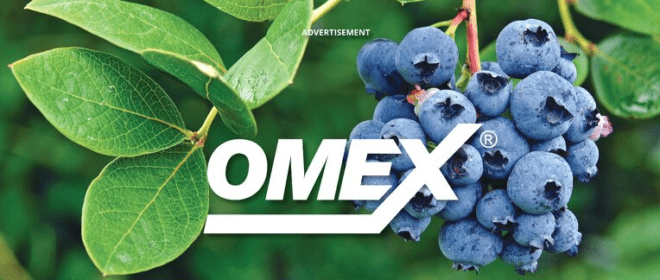Nov 5, 2020Blueberries: time to look ahead to 2021


(Sponsored) Blueberry growers almost certainly won’t be celebrating 2020 as one of the great years, but 2021 can always be better. Now’s the time to give some thought to planning and preparation, writes Mike Williams of OMEX® Agrifluids.
Late frosts, drought and labor shortages, much of the latter a result of COVID-19, have transpired to make this year’s harvest distinctly average. At the time of writing, the detail for 2020 isn’t yet apparent, but it’s clear that across the country, it’s been a mixed bag with pockets of high-quality produce from some states balanced by conspicuously poor performance in others.
In the U.S. the blueberry season typically runs from March to October, when we switch to imported berries. And although much of the agronomic attention focuses on plant performance during the growing season itself, fall nevertheless presents an opportunity for growers to take stock and consider the next season.
Although widely grown and enjoyed, the blueberry is one of those crops whose agronomy still isn’t fully understood. We know a lot about it, but we don’t know everything — especially when it comes to dealing with nutrients and micronutrients. This is most obvious when it comes to assessing nutrient deficiencies: while the deficiency may be easy to detect, it’s not always so easy to identify which nutrient or micronutrient is lacking.
One element with some interest for growers around this time of year is boron. As a micronutrient, it’s required only in very small amounts: a minimum of around 30ppm, although 70ppm is ideal and 200ppm is too much. Yet it plays a crucial role in many processes within the plant: cell division, metabolization of nitrogen, potassium transport, the formation of cell walls and protein formation. It also makes critical contributions to pollen germination and cell elongation — processes central to fruit set and development.
Blueberry growers have often been encouraged to make fall applications of boron, the intention being to increase fruit set and/or yield in the following year. That’s because the fruit buds for the following season are already developing at this time.
Yet while several researchers have failed to find any convincing effect on fruit set or yield from these fall applications, studies have identified a possible link between foliar applications of boron and reduced winter injury to developing fruit buds. They also found that applications of foliar boron in fall increased the levels of tissue boron in first crop fruit buds. This suggests that a foliar boron application — such as Cell Power® Boron Zinc, which will also benefit root structure, which in turn will improve calcium transport (see below) — can hold value; it will be interesting to see how further research clarifies the position and whether a firmer link can be established.
Nevertheless, if soil or tissue analysis has identified low levels or even a deficiency of boron, it’s likely that a fall application — best applied some five to six weeks after harvest — could prove beneficial.
Another critical element for blueberries is calcium, although this won’t be relevant until the new season gets underway: calcium is needed most in the period after flowering, before the fruit reaches 1/8”. Growers strive to achieve high levels of calcium, for it improves berry quality as well as shelf life. But it’s difficult to get right; growers often end up applying vast quantities of calcium to little effect, yet the difference between good quality fruit and fruit with poor shelf life is around two or three parts per million. Very small! There’s also evidence that calcium and boron can interact: too much calcium can lead to a deficiency of boron.
At OMEX®, we’ve been fortunate to benefit from a valuable partnership with a British firm, Levity Crop Science. Developed through years of research, their LoCal technology has proved a real breakthrough in calcium management.
Featured in OMEX® Cell Power® Calcium Gold, LoCal provides fruit growers — of apples, strawberries and other fruits as well as blueberries — with a proven and consistent means of allowing calcium absorption at the critical time, in managed quantities, at low doses. The reason it’s far more effective? It stimulates the plant to absorb calcium in the absence of auxin, a critical plant hormone. It’s the absence of auxin that sees conventional forms of calcium deliver little or, more usually, inconsistent effects.
It’s technology like LoCal that shows there’s still room for serious and exciting innovation in plant nutrition. It’s great to share these opportunities to further improve productivity of fruit and vegetables with America’s farmers and we’re looking forward to developing them further in 2021.
Learn more at www.omexusa.com.
The product names and brands referenced here are registered and trademarks of OMEX® Agrifluids, Inc.
© OMEX® Agrifluids, Inc. 2020.














